Min Gao
Gated Rotary-Enhanced Linear Attention for Long-term Sequential Recommendation
Jun 16, 2025Abstract:In Sequential Recommendation Systems (SRSs), Transformer models show remarkable performance but face computation cost challenges when modeling long-term user behavior sequences due to the quadratic complexity of the dot-product attention mechanism. By approximating the dot-product attention, linear attention provides an efficient option with linear complexity. However, existing linear attention methods face two limitations: 1) they often use learnable position encodings, which incur extra computational costs in long-term sequence scenarios, and 2) they may not consider the user's fine-grained local preferences and confuse these with the actual change of long-term interests. To remedy these drawbacks, we propose a long-term sequential Recommendation model with Gated Rotary Enhanced Linear Attention (RecGRELA). Specifically, we first propose a Rotary-Enhanced Linear Attention (RELA) module to model long-range dependency within the user's historical information using rotary position encodings. We then introduce a local short operation to incorporate local preferences and demonstrate the theoretical insight. We further introduce a SiLU-based Gated mechanism for RELA (GRELA) to help the model determine whether a user's behavior indicates local interest or a genuine shift in long-term preferences. Experimental results on four public datasets demonstrate that our RecGRELA achieves state-of-the-art performance compared to existing SRSs while maintaining low memory overhead.
RuleAgent: Discovering Rules for Recommendation Denoising with Autonomous Language Agents
Mar 30, 2025Abstract:The implicit feedback (e.g., clicks) in real-world recommender systems is often prone to severe noise caused by unintentional interactions, such as misclicks or curiosity-driven behavior. A common approach to denoising this feedback is manually crafting rules based on observations of training loss patterns. However, this approach is labor-intensive and the resulting rules often lack generalization across diverse scenarios. To overcome these limitations, we introduce RuleAgent, a language agent based framework which mimics real-world data experts to autonomously discover rules for recommendation denoising. Unlike the high-cost process of manual rule mining, RuleAgent offers rapid and dynamic rule discovery, ensuring adaptability to evolving data and varying scenarios. To achieve this, RuleAgent is equipped with tailored profile, memory, planning, and action modules and leverages reflection mechanisms to enhance its reasoning capabilities for rule discovery. Furthermore, to avoid the frequent retraining in rule discovery, we propose LossEraser-an unlearning strategy that streamlines training without compromising denoising performance. Experiments on benchmark datasets demonstrate that, compared with existing denoising methods, RuleAgent not only derives the optimal recommendation performance but also produces generalizable denoising rules, assisting researchers in efficient data cleaning.
Phi-4-Mini Technical Report: Compact yet Powerful Multimodal Language Models via Mixture-of-LoRAs
Mar 03, 2025Abstract:We introduce Phi-4-Mini and Phi-4-Multimodal, compact yet highly capable language and multimodal models. Phi-4-Mini is a 3.8-billion-parameter language model trained on high-quality web and synthetic data, significantly outperforming recent open-source models of similar size and matching the performance of models twice its size on math and coding tasks requiring complex reasoning. This achievement is driven by a carefully curated synthetic data recipe emphasizing high-quality math and coding datasets. Compared to its predecessor, Phi-3.5-Mini, Phi-4-Mini features an expanded vocabulary size of 200K tokens to better support multilingual applications, as well as group query attention for more efficient long-sequence generation. Phi-4-Multimodal is a multimodal model that integrates text, vision, and speech/audio input modalities into a single model. Its novel modality extension approach leverages LoRA adapters and modality-specific routers to allow multiple inference modes combining various modalities without interference. For example, it now ranks first in the OpenASR leaderboard to date, although the LoRA component of the speech/audio modality has just 460 million parameters. Phi-4-Multimodal supports scenarios involving (vision + language), (vision + speech), and (speech/audio) inputs, outperforming larger vision-language and speech-language models on a wide range of tasks. Additionally, we experiment to further train Phi-4-Mini to enhance its reasoning capabilities. Despite its compact 3.8-billion-parameter size, this experimental version achieves reasoning performance on par with or surpassing significantly larger models, including DeepSeek-R1-Distill-Qwen-7B and DeepSeek-R1-Distill-Llama-8B.
Breaking the Clusters: Uniformity-Optimization for Text-Based Sequential Recommendation
Feb 19, 2025Abstract:Traditional sequential recommendation (SR) methods heavily rely on explicit item IDs to capture user preferences over time. This reliance introduces critical limitations in cold-start scenarios and domain transfer tasks, where unseen items and new contexts often lack established ID mappings. To overcome these limitations, recent studies have shifted towards leveraging text-only information for recommendation, thereby improving model generalization and adaptability across domains. Although promising, text-based SR faces unique difficulties: items' text descriptions often share semantic similarities that lead to clustered item representations, compromising their uniformity, a property essential for promoting diversity and enhancing generalization in recommendation systems. In this paper, we explore a novel framework to improve the uniformity of item representations in text-based SR. Our analysis reveals that items within a sequence exhibit marked semantic similarity, meaning they are closer in representation than items overall, and that this effect is more pronounced for less popular items, which form tighter clusters compared to their more popular counterparts. Based on these findings, we propose UniT, a framework that employs three pairwise item sampling strategies: Unified General Sampling Strategy, Sequence-Driven Sampling Strategy, and Popularity-Driven Sampling Strategy. Each strategy applies varying degrees of repulsion to selectively adjust the distances between item pairs, thereby refining representation uniformity while considering both sequence context and item popularity. Extensive experiments on multiple real-world datasets demonstrate that our proposed approach outperforms state-of-the-art models, validating the effectiveness of UniT in enhancing both representation uniformity and recommendation accuracy.The source code is available at https://github.com/ccwwhhh/Model-Rec.
Graph with Sequence: Broad-Range Semantic Modeling for Fake News Detection
Dec 07, 2024



Abstract:The rapid proliferation of fake news on social media threatens social stability, creating an urgent demand for more effective detection methods. While many promising approaches have emerged, most rely on content analysis with limited semantic depth, leading to suboptimal comprehension of news content.To address this limitation, capturing broader-range semantics is essential yet challenging, as it introduces two primary types of noise: fully connecting sentences in news graphs often adds unnecessary structural noise, while highly similar but authenticity-irrelevant sentences introduce feature noise, complicating the detection process. To tackle these issues, we propose BREAK, a broad-range semantics model for fake news detection that leverages a fully connected graph to capture comprehensive semantics while employing dual denoising modules to minimize both structural and feature noise. The semantic structure denoising module balances the graph's connectivity by iteratively refining it between two bounds: a sequence-based structure as a lower bound and a fully connected graph as the upper bound. This refinement uncovers label-relevant semantic interrelations structures. Meanwhile, the semantic feature denoising module reduces noise from similar semantics by diversifying representations, aligning distinct outputs from the denoised graph and sequence encoders using KL-divergence to achieve feature diversification in high-dimensional space. The two modules are jointly optimized in a bi-level framework, enhancing the integration of denoised semantics into a comprehensive representation for detection. Extensive experiments across four datasets demonstrate that BREAK significantly outperforms existing methods in identifying fake news. Code is available at https://anonymous.4open.science/r/BREAK.
LLM-Powered Text Simulation Attack Against ID-Free Recommender Systems
Sep 19, 2024



Abstract:The ID-free recommendation paradigm has been proposed to address the limitation that traditional recommender systems struggle to model cold-start users or items with new IDs. Despite its effectiveness, this study uncovers that ID-free recommender systems are vulnerable to the proposed Text Simulation attack (TextSimu) which aims to promote specific target items. As a novel type of text poisoning attack, TextSimu exploits large language models (LLM) to alter the textual information of target items by simulating the characteristics of popular items. It operates effectively in both black-box and white-box settings, utilizing two key components: a unified popularity extraction module, which captures the essential characteristics of popular items, and an N-persona consistency simulation strategy, which creates multiple personas to collaboratively synthesize refined promotional textual descriptions for target items by simulating the popular items. To withstand TextSimu-like attacks, we further explore the detection approach for identifying LLM-generated promotional text. Extensive experiments conducted on three datasets demonstrate that TextSimu poses a more significant threat than existing poisoning attacks, while our defense method can detect malicious text of target items generated by TextSimu. By identifying the vulnerability, we aim to advance the development of more robust ID-free recommender systems.
Research on Adverse Drug Reaction Prediction Model Combining Knowledge Graph Embedding and Deep Learning
Jul 27, 2024
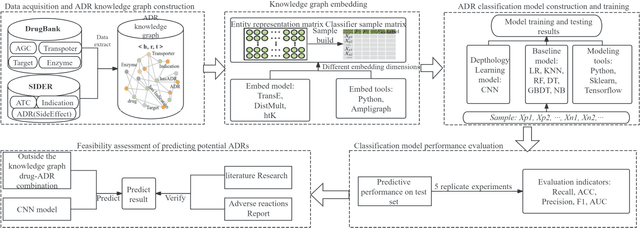
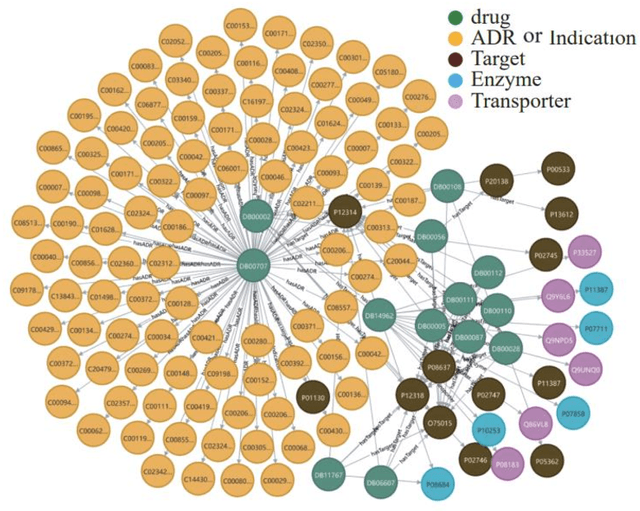

Abstract:In clinical treatment, identifying potential adverse reactions of drugs can help assist doctors in making medication decisions. In response to the problems in previous studies that features are high-dimensional and sparse, independent prediction models need to be constructed for each adverse reaction of drugs, and the prediction accuracy is low, this paper develops an adverse drug reaction prediction model based on knowledge graph embedding and deep learning, which can predict experimental results. Unified prediction of adverse drug reactions covered. Knowledge graph embedding technology can fuse the associated information between drugs and alleviate the shortcomings of high-dimensional sparsity in feature matrices, and the efficient training capabilities of deep learning can improve the prediction accuracy of the model. This article builds an adverse drug reaction knowledge graph based on drug feature data; by analyzing the embedding effect of the knowledge graph under different embedding strategies, the best embedding strategy is selected to obtain sample vectors; and then a convolutional neural network model is constructed to predict adverse reactions. The results show that under the DistMult embedding model and 400-dimensional embedding strategy, the convolutional neural network model has the best prediction effect; the average accuracy, F_1 score, recall rate and area under the curve of repeated experiments are better than the methods reported in the literature. The obtained prediction model has good prediction accuracy and stability, and can provide an effective reference for later safe medication guidance.
Consistency and Discrepancy-Based Contrastive Tripartite Graph Learning for Recommendations
Jul 06, 2024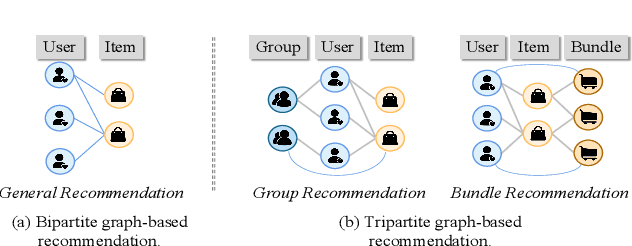
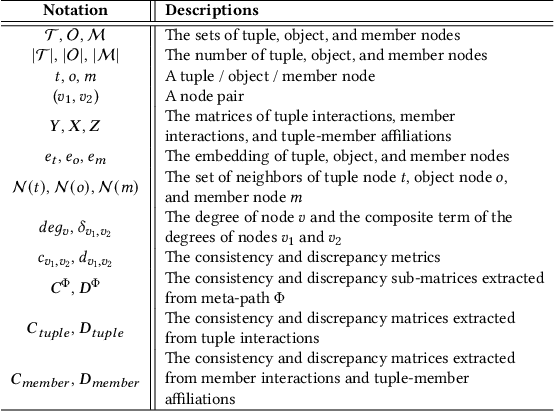
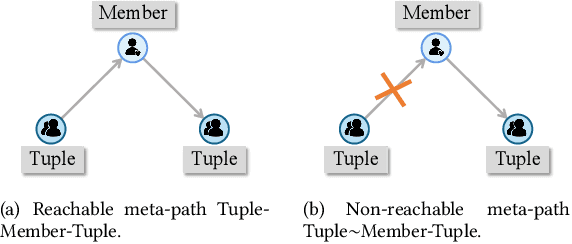

Abstract:Tripartite graph-based recommender systems markedly diverge from traditional models by recommending unique combinations such as user groups and item bundles. Despite their effectiveness, these systems exacerbate the longstanding cold-start problem in traditional recommender systems, because any number of user groups or item bundles can be formed among users or items. To address this issue, we introduce a Consistency and Discrepancy-based graph contrastive learning method for tripartite graph-based Recommendation. This approach leverages two novel meta-path-based metrics consistency and discrepancy to capture nuanced, implicit associations between the recommended objects and the recommendees. These metrics, indicative of high-order similarities, can be efficiently calculated with infinite graph convolutional networks layers under a multi-objective optimization framework, using the limit theory of GCN.
PFME: A Modular Approach for Fine-grained Hallucination Detection and Editing of Large Language Models
Jun 29, 2024



Abstract:Large Language Models (LLMs) excel in fluency but risk producing inaccurate content, called "hallucinations." This paper outlines a standardized process for categorizing fine-grained hallucination types and proposes an innovative framework--the Progressive Fine-grained Model Editor (PFME)--specifically designed to detect and correct fine-grained hallucinations in LLMs. PFME consists of two collaborative modules: the Real-time Fact Retrieval Module and the Fine-grained Hallucination Detection and Editing Module. The former identifies key entities in the document and retrieves the latest factual evidence from credible sources. The latter further segments the document into sentence-level text and, based on relevant evidence and previously edited context, identifies, locates, and edits each sentence's hallucination type. Experimental results on FavaBench and FActScore demonstrate that PFME outperforms existing methods in fine-grained hallucination detection tasks. Particularly, when using the Llama3-8B-Instruct model, PFME's performance in fine-grained hallucination detection with external knowledge assistance improves by 8.7 percentage points (pp) compared to ChatGPT. In editing tasks, PFME further enhances the FActScore of FActScore-Alpaca13B and FActScore-ChatGPT datasets, increasing by 16.2pp and 4.6pp, respectively.
Poisoning Attacks and Defenses in Recommender Systems: A Survey
Jun 03, 2024Abstract:Modern recommender systems (RS) have profoundly enhanced user experience across digital platforms, yet they face significant threats from poisoning attacks. These attacks, aimed at manipulating recommendation outputs for unethical gains, exploit vulnerabilities in RS through injecting malicious data or intervening model training. This survey presents a unique perspective by examining these threats through the lens of an attacker, offering fresh insights into their mechanics and impacts. Concretely, we detail a systematic pipeline that encompasses four stages of a poisoning attack: setting attack goals, assessing attacker capabilities, analyzing victim architecture, and implementing poisoning strategies. The pipeline not only aligns with various attack tactics but also serves as a comprehensive taxonomy to pinpoint focuses of distinct poisoning attacks. Correspondingly, we further classify defensive strategies into two main categories: poisoning data filtering and robust training from the defender's perspective. Finally, we highlight existing limitations and suggest innovative directions for further exploration in this field.
 Add to Chrome
Add to Chrome Add to Firefox
Add to Firefox Add to Edge
Add to Edge